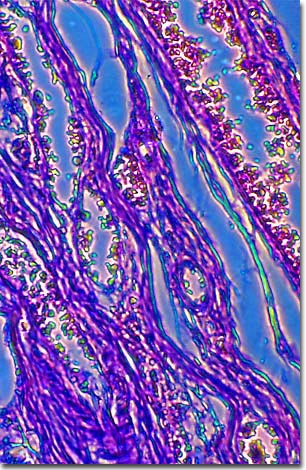Phase Contrast Image Gallery
Lymph Node Carcinoma
A stained thin section of human lymph node reveals damage caused by a carcinoma. As evidenced by this micrograph, combining phase contrast microscopy with classical histological staining techniques often yields enhancement of cellular features.

Cancer of the lymph nodes can originate in a number of ways. Lymphomas originate in the lymphatic system, itself. There are two main groups of lymphomas, Hodgkin's Disease and Non-Hodgkin's Lymphoma. Other lymph node cancers come from malignancies that originate in other parts of the body. Cancer cells metastasize (travel to distant locations) from the original site through the lymphatic system. The lymph nodes then filter out the cancer cells the same way they do infectious organisms and debris. Sometimes the cancer cells are destroyed by white blood cells in the nodes, but if they're not, they will lodge there and begin to grow. Enlargement of lymph nodes is often the first sign that an existing cancer has spread.
Lymph nodes are part of the lymphatic system, which works with the circulatory system essentially as an auxiliary janitorial and security service for the body. The lymphatic system carries lymph, the excess fluid from body tissues, into the veins of the circulatory system. Lymph is similar to blood in that it carries nutrients and oxygen to the cells and collects waste products, but contains no red blood cells or platelets. Muscle movement squeezes fluids from body tissues into the capillaries of the lymph system. From there the fluid, or lymph, is carried to the lymph nodes, which are distributed throughout the body.
The lymph nodes have three primary functions: 1) to filter out and destroy foreign substances, such as bacteria and debris; 2) to produce white blood cells called lymphocytes; and 3) to produce antibodies for the body's immune system. After the lymph has been "cleaned" of dangerous microbes and materials, it is returned to the bloodstream.
BACK TO THE PHASE CONTRAST GALLERY
